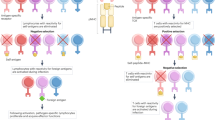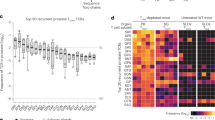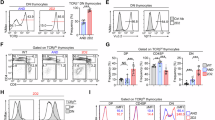Abstract
Signaling through the T cell antigen receptor leading to elimination (negative selection) or differentiation (positive selection) of developing thymocytes generates a self-tolerant T cell repertoire. Here we report that the serine-threonine kinase MINK selectively connects the T cell receptor to a signaling pathway that mediates negative but not positive selection. Analysis of this pathway suggested that the essential function of MINK in the elimination of self-reactive thymocytes may be associated with 'downstream' activation of Jun kinase and enhancement of expression of the proapoptotic molecule Bim.
This is a preview of subscription content, access via your institution
Access options
Subscribe to this journal
Receive 12 print issues and online access
$259.00 per year
only $21.58 per issue
Buy this article
- Purchase on SpringerLink
- Instant access to full article PDF
Prices may be subject to local taxes which are calculated during checkout






Similar content being viewed by others
References
Alberola-Ila, J., Forbush, K.A., Seger, R., Krebs, E.G. & Perlmutter, R.M. Selective requirement for MAP kinase activation in thymocyte differentiation. Nature 373, 620–623 (1995).
Backstrom, B.T., Muller, U., Hausmann, B. & Palmer, E. Positive selection through a motif in the αβ T cell receptor. Science 281, 835–838 (1998).
Werlen, G., Hausmann, B. & Palmer, E. A motif in the αβ T–cell receptor controls positive selection by modulating Erk activity. Nature 406, 422–426 (2000).
Delgado, P., Fernandez, E., Dave, V., Kappes, D. & Alarcon, B. CD3δ couples T–cell receptor signalling to Erk activation and thymocyte positive selection. Nature 406, 426–430 (2000).
Hailman, E., Burack, W.R., Shaw, A.S., Dustin, M.L. & Allen, P.M. Immature CD4+CD8+ thymocytes form a multifocal immunological synapse with sustained tyrosine phosphorylation. Immunity 16, 839–848 (2002).
Neilson, J.R., Winslow, M.M., Hur, E.M. & Crabtree, G.R. Calcineurin B1 is essential for positive but not negative selection during thymocyte development. Immunity 20, 255–266 (2004).
Bouillet, P. et al. BH3-only Bcl-2 family member Bim is required for apoptosis of autoreactive thymocytes. Nature 415, 922–926 (2002).
Strasser, A. & Bouillet, P. The control of apoptosis in lymphocyte selection. Immunol. Rev. 193, 82–92 (2003).
Rincon, M. et al. The Jnk pathway regulates the in vivo deletion of immature CD4+CD8+ thymocytes. J. Exp. Med. 188, 1817–1830 (1998).
McCarty, N., Shinohara, M.L., Lu, L. & Cantor, H. Detailed analysis of gene expression during development of T cell lineages in the thymus. Proc. Natl. Acad. Sci. USA 101, 9339–9344 (2004).
Brummelkamp, T.R., Bernards, R. & Agami, R. A system for stable expression of short interfering RNAs in mammalian cells. Science 296, 550–553 (2002).
Sui, G. et al. A DNA vector–based RNAi technology to suppress gene expression in mammalian cells. Proc. Natl. Acad. Sci. USA 99, 5515–5520 (2002).
Rubinson, D.A. et al. A lentivirus–based system to functionally silence genes in primary mammalian cells, stem cells and transgenic mice by RNA interference. Nat. Genet. 33, 401–406 (2003).
Baribaud, F. et al. Identification of key amino acids of the mouse mammary tumor virus superantigen involved in the specific interaction with T–cell receptor V(beta) domains. J. Virol. 75, 7453–7461 (2001).
Ali, M., Weinreich, M., Balcaitis, S., Cooper, C.J. & Fink, P.J. Differential regulation of peripheral CD4+ T cell tolerance induced by deletion and TCR revision. J. Immunol. 171, 6290–6296 (2003).
Zhan, Y. et al. Without peripheral interference, thymic deletion is mediated in a cohort of double–positive cells without classical activation. Proc. Natl. Acad. Sci. USA 100, 1197–1202 (2003).
Kisielow, P., Teh, H.S., Bluthmann, H. & von Boehmer, H. Positive selection of antigen–specific T cells in thymus by restricting MHC molecules. Nature 335, 730–733 (1988).
Teh, H.S. et al. Early deletion and late positive selection of T cells expressing a male-specific receptor in T-cell receptor transgenic mice. Dev. Immunol. 1, 1–10 (1990).
Dan, I. et al. Molecular cloning of MINK, a novel member of mammalian GCK family kinases, which is up-regulated during postnatal mouse cerebral development. FEBS Lett. 469, 19–23 (2000).
McCarty, J.H. The Nck SH2/SH3 adaptor protein: a regulator of multiple intracellular signal transduction events. Bioessays 20, 913–921 (1998).
Gil, D., Schamel, W.W., Montoya, M., Sanchez-Madrid, F. & Alarcon, B. Recruitment of Nck by CD3ε reveals a ligand-induced conformational change essential for T cell receptor signaling and synapse formation. Cell 109, 901–912 (2002).
Davis, M.M. A new trigger for T cells. Cell 110, 285–287 (2002).
Rincon, M., Flavell, R.A. & Davis, R.A. The Jnk and P38 MAP kinase signaling pathways in T cell–mediated immune responses. Free Radic. Biol. Med. 28, 1328–1337 (2000).
Sabapathy, K. et al. Jnk2 is required for efficient T-cell activation and apoptosis but not for normal lymphocyte development. Curr. Biol. 9, 116–125 (1999).
Sabapathy, K. et al. c-Jun NH2-terminal kinase (Jnk)1 and Jnk2 have similar and stage–dependent roles in regulating T cell apoptosis and proliferation. J. Exp. Med. 193, 317–328 (2001).
Harris, C.A. & Johnson, E.M., Jr. BH3-only Bcl-2 family members are coordinately regulated by the Jnk pathway and require Bax to induce apoptosis in neurons. J. Biol. Chem. 276, 37754–37760 (2001).
Putcha, G.V. et al. Induction of BIM, a proapoptotic BH3-only BCL-2 family member, is critical for neuronal apoptosis. Neuron 29, 615–628 (2001).
Whitfield, J., Neame, S.J., Paquet, L., Bernard, O. & Ham, J. Dominant-negative c-Jun promotes neuronal survival by reducing BIM expression and inhibiting mitochondrial cytochrome c release. Neuron 29, 629–643 (2001).
Dan, I., Watanabe, N.M. & Kusumi, A. The Ste20 group kinases as regulators of MAP kinase cascades. Trends Cell Biol. 11, 220–230 (2001).
Davis, R.J. Signal transduction by the Jnk group of MAP kinases. Cell 103, 239–252 (2000).
Fanger, G.R., Gerwins, P., Widmann, C., Jarpe, M.B. & Johnson, G.L. MEKKs, GCKs, MLKs, PAKs, TAKs, and tpls: upstream regulators of the c-Jun amino-terminal kinases? Curr. Opin. Genet. Dev. 7, 67–74 (1997).
Lei, K. et al. The Bax subfamily of Bcl2–related proteins is essential for apoptotic signal transduction by c-Jun NH2-terminal kinase. Mol. Cell. Biol. 22, 4929–4942 (2002).
Behrens, A. et al. Jun N-terminal kinase 2 modulates thymocyte apoptosis and T cell activation through c-Jun and nuclear factor of activated T cell (NF-AT). Proc. Natl. Acad. Sci. USA 98, 1769–1774 (2001).
Singer, A. New perspectives on a developmental dilemma: the kinetic signaling model and the importance of signal duration for the CD4/CD8 lineage decision. Curr. Opin. Immunol. 14, 207–215 (2002).
Akashi, K., Kondo, M. & Weissman, I.L. Two distinct pathways of positive selection for thymocytes. Proc. Natl. Acad. Sci. USA 95, 2486–2491 (1998).
Ninomiya-Tsuji, J. et al. The kinase TAK1 can activate the NIK-IκB as well as the MAP kinase cascade in the IL-1 signalling pathway. Nature 398, 252–256 (1999).
Acknowledgements
We thank J. Levecchio for cell sorting; K. Akashi for discussions and critical comments; and A. Angel for assistance with the manuscript and figures. Supported by National Research Service Award (T32 AI07386 to N.M.).
Author information
Authors and Affiliations
Corresponding author
Ethics declarations
Competing interests
The authors declare no competing financial interests.
Supplementary information
Supplementary Fig. 1
Sorting of thymic subpopulations for real time PCRs. (PDF 201 kb)
Supplementary Fig. 2
Additional analysis of MINK mice. (PDF 273 kb)
Supplementary Fig. 3
Additional analysis of HY MINK and HY control chimeric mice. (PDF 149 kb)
Rights and permissions
About this article
Cite this article
McCarty, N., Paust, S., Ikizawa, K. et al. Signaling by the kinase MINK is essential in the negative selection of autoreactive thymocytes. Nat Immunol 6, 65–72 (2005). https://doi.org/10.1038/ni1145
Received:
Accepted:
Published:
Issue date:
DOI: https://doi.org/10.1038/ni1145
This article is cited by
-
Priming of NLRP3 inflammasome activation by Msn kinase MINK1 in macrophages
Cellular & Molecular Immunology (2021)
-
Trx1/TrxR1 system regulates post‐selected DP thymocytes survival by modulating ASK1‐JNK/p38 MAPK activities
Immunology & Cell Biology (2015)
-
CBAP promotes thymocyte negative selection by facilitating T-cell receptor proximal signaling
Cell Death & Disease (2014)
-
Molecular and genetic parameters defining T‐cell clonal selection
Immunology & Cell Biology (2011)
-
Shaping the T‐cell repertoire: a matter of life and death
Immunology & Cell Biology (2011)



